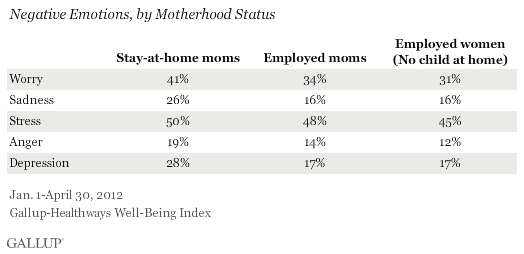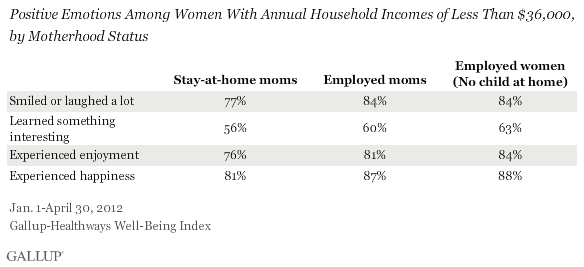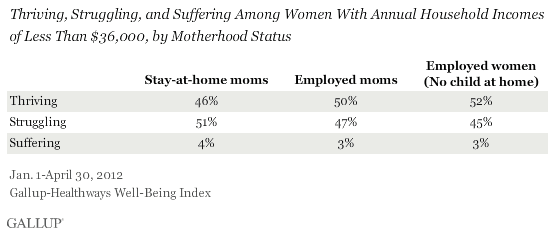WASHINGTON, D.C. -- The degree of difficulty of being a stay-at-home parent is evident in a new Gallup analysis of more than 60,000 U.S. women interviewed in 2012. Non-employed women with young children at home are more likely than women with young children at home who are employed for pay to report experiencing sadness and anger a lot of the day "yesterday." Stay-at-home moms are also much more likely to report having ever been diagnosed with depression than employed moms. Employed moms are about as emotionally well-off as working women who do not have children at home.

This analysis examines adult women between the ages of 18 and 64 -- that is, before retirement age. "Stay-at-home moms" are defined as women who are not currently employed and have a child younger than 18 at home. Gallup looked separately at non-employed moms who are looking for work and those who are not looking -- to distinguish between those who may not be employed because of circumstance rather than by choice -- and both groups are more likely to report anger, sadness, and depression than are employed moms. It is also important to note that these findings are not related to age -- that is, even when controlling for age, stay-at-home moms are emotionally worse off than employed moms.
"Employed moms" are women who are employed full or part time and have a child younger than 18 in their household. "Employed women" are those employed full or part time who do not have a child younger than 18 at home -- so this group includes women who have never had children and those whose children are grown and no longer living at home.
Stay-at-home moms also lag behind employed moms in terms of their daily positive emotions: They are less likely to say they smiled or laughed a lot, learned something interesting, and experienced enjoyment and happiness "yesterday." Additionally, they are less likely than employed moms to rate their lives highly enough to be considered "thriving."

Low-Income Stay-at-Home Moms Struggle the Most
Stay-at-home moms fare worse than employed moms at every income level in terms of sadness, anger, and depression. On the other items Gallup measures -- laughter, enjoyment, happiness, worry, stress, learning something interesting, and having a high life evaluation rating -- middle- and high-income stay-at-home moms for the most part do as well as employed moms.
However, low-income stay-at-home moms do worse on all of these items than their employed counterparts. These moms -- with annual household incomes of less than $36,000 -- are less likely than employed moms at this income level to say they smiled or laughed a lot or experienced happiness or enjoyment "yesterday." They are also slightly less likely to say they learned something interesting.

Low-income stay-at-home moms are also more likely to say they have experienced daily worry and stress than low-income employed moms.

Low-income stay-at-home moms' emotional struggles are likely contributing to their lower life ratings. These moms are less likely than employed low-income moms to rate their lives highly enough to be considered thriving. In fact, low-income stay-at-home moms are more likely to be struggling in their lives than thriving -- the opposite of employed moms and employed women with no children at home.

Bottom Line
Stay-at-home moms at all income levels are worse off than employed moms in terms of sadness, anger, and depression, though they are the same as other women in most other aspects of emotional well-being. Employed moms, however, are doing as well as employed women without children at home -- possibly revealing that formal employment, or perhaps the income associated with it, has emotional benefits for mothers.
However, low-income stay-at-home moms are struggling the most. Many in this group are likely staying home out of economic necessity rather than by choice, and they likely feel pressure from tight finances and the demands of motherhood. Even stay-at-home moms who are not looking for work are worse off emotionally than are their employed counterparts -- suggesting there may be other issues related to their higher levels of sadness, anger, and depression.
While many mothers are rightfully dedicated to parenting as an important and fulfilling vocation, those who desire to work should feel encouraged by these data to pursue it. And for those who choose to stay home, more societal recognition of the difficult job stay-at-home mothers have raising children would perhaps help support them emotionally.
Of course, for stay-at-home moms who wish to pursue employment, the cost of child care may be prohibitive. Increasing employer-sponsored or other types of subsidized and low-cost child care may be a means to helping create more choices for stay-at-homes.
Ensuring that stay-at-home moms are in good emotional shape is critical not only for the sake of these mothers, but also for the sake of their children's and families' well-being.
About the Gallup-Healthways Well-Being Index
The Gallup-Healthways Well-Being Index tracks well-being in the U.S., U.K., and Germany and provides best-in-class solutions for a healthier world. To learn more, please visit well-beingindex.com.
Survey Methods
Results are based on telephone interviews conducted as part of the Gallup-Healthways Well-Being Index survey Jan. 1-April 30, 2012, with a random sample of 60,799 women, aged 18 to 64, living in all 50 U.S. states and the District of Columbia, selected using random-digit-dial sampling.
For results based on the total sample of national women, one can say with 95% confidence that the maximum margin of sampling error is ±1 percentage point.
Interviews are conducted with respondents on landline telephones and cellular phones, with interviews conducted in Spanish for respondents who are primarily Spanish-speaking. Each sample includes a minimum quota of 400 cell phone respondents and 600 landline respondents per 1,000 national adults, with additional minimum quotas among landline respondents by region. Landline telephone numbers are chosen at random among listed telephone numbers. Cell phone numbers are selected using random-digit-dial methods. Landline respondents are chosen at random within each household on the basis of which member had the most recent birthday.
Samples are weighted by gender, age, race, Hispanic ethnicity, education, region, adults in the household, and phone status (cell phone only/landline only/both, cell phone mostly, and having an unlisted landline number). Demographic weighting targets are based on the March 2010 Current Population Survey figures for the aged 18 and older non-institutionalized population living in U.S. telephone households. All reported margins of sampling error include the computed design effects for weighting and sample design.
In addition to sampling error, question wording and practical difficulties in conducting surveys can introduce error or bias into the findings of public opinion polls.
For more details on Gallup's polling methodology, visit https://www.gallup.com/.
